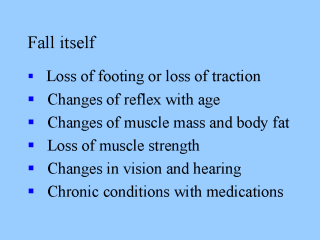| front |1 |2 |3 |4 |5 |6 |7 |8 |9 |10 |11 |12 |13 |14 |15 |16 |17 |18 |19 |20 |21 |22 |23 |24 |25 |26 |27 |28 |29 |30 |31 |32 |review |
 |
There are several
reasons that can lead to a fall besides fragile bone and force of fall. Loss of footing or loss of traction are common causes of fall. Loss of footing occurs when there is less than total contact between the person's foot and the ground or floor. Loss of traction happens when the ground upon the person is stepping is wet or slippery. Other examples of loss of traction are tripping, especially over uneven surfaces such as sidewalks, curbs or scatter rugs. A fall may occur because a person's reflexes have changed over age. When people age, reflexes slow down. Reflexes are automatic responses to stimuli in the environment. Examples of reflexes includes quickly moving out of the way when something accidentally falls. Aging slows the person's reaction time and make it harder to regain the balance following sudden movement of shift of body weight. |